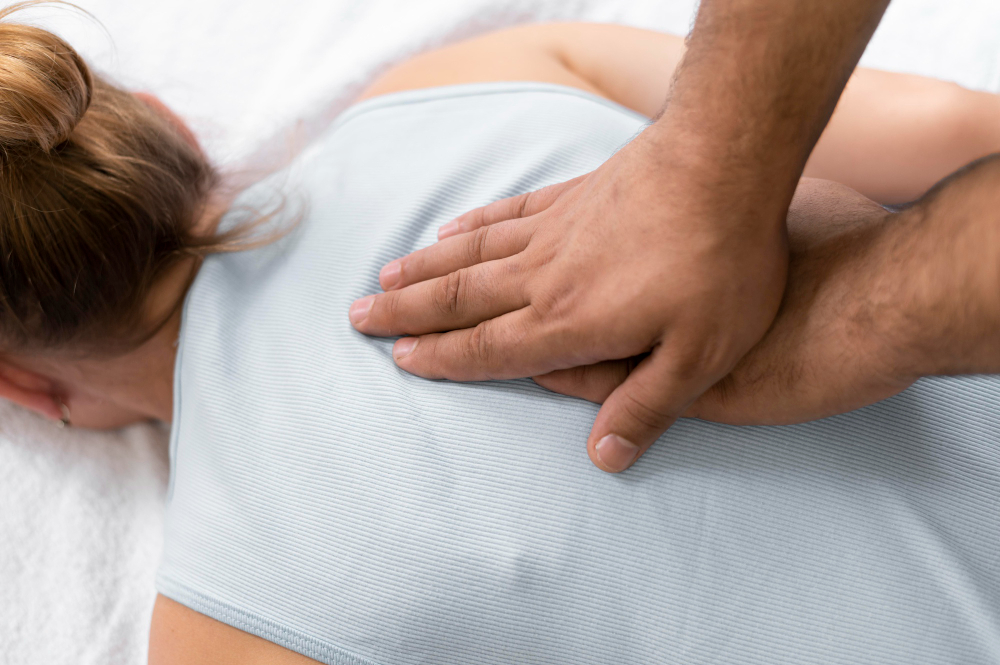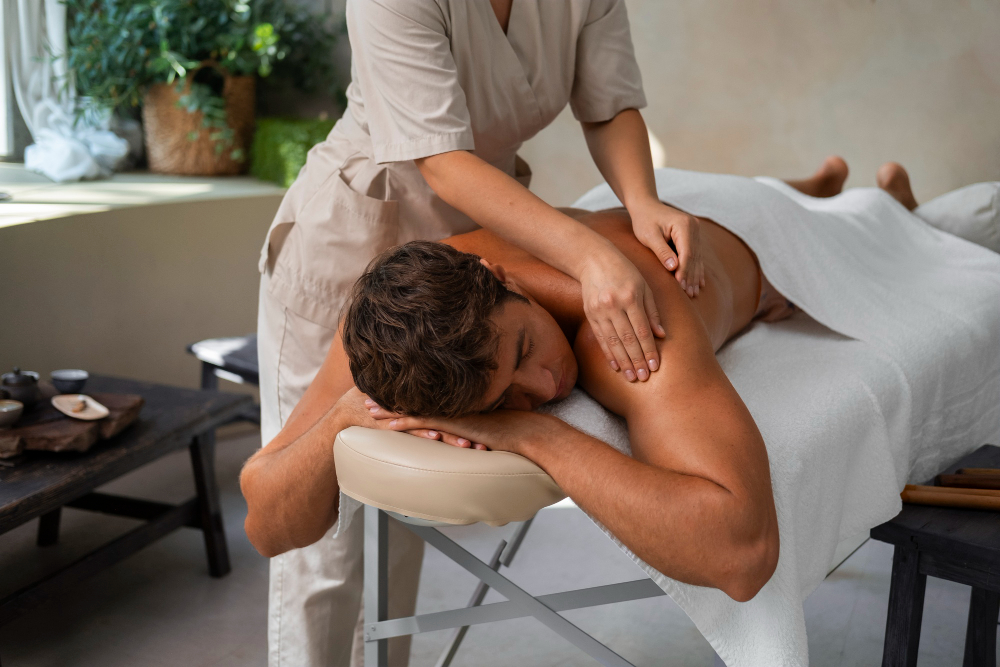Have you ever gone for a professional massage therapy, expecting to emerge feeling relaxed and rejuvenated, only to wake up the next morning dealing with muscle soreness and aches? While it may seem counterintuitive, feeling a bit sore and stiff after a massage is actually quite common.
This post will explore the reasons behind why we often feel sore after a massage and offer practical tips for finding relief from this temporary soreness. We’ll also discuss when lingering soreness may be a cause for concern. While the phenomenon may seem strange, it’s important to understand that feeling a bit sore is not a reason to avoid massage therapy. With the right approach and self-care remedies, you can enjoy the long-term benefits while managing any short-term discomfort.
Causes of post-massage pain and soreness
- Deep tissue massage therapy and other firm techniques
- Deep tissue, trigger point therapy, and myofascial release massages all involve applying concentrated pressure and friction to access deeper layers of muscle and connective tissue. These techniques can break up muscle adhesions, knots, and areas of built-up tension.
- This intense pressure creates micro-tears and inflammation in the muscle fibers as they are forcibly untangled, released, and lengthened. While therapeutic, this process can leave the muscles feeling sore and tender afterwards.
- Muscles being “worked out” and lactic acid buildup
- During a firm, therapeutic massage, the muscles are being strenuously worked and contracted, similar to a tough workout at the gym.
- This causes a buildup of lactic acid and other metabolic byproducts in the muscle tissue.
- Just like after exercising, this lactic acid buildup can lead to inflammation and that achy, sore feeling as the muscles work to flush it out and repair.
- Releasing long-held muscle tension and knots
- Many people seek out massage therapy to release chronic muscle tension, adhesions, and “knots” that have built up over time.
- When these long-standing areas of tightness are finally undone, it disrupts the muscles’ adjusted state, causing them to feel sore as they adjust to their new relaxed state.
- Think of it like recovering from a muscle strain or tear – that released tightness puts stress on the fibers.
- Increased Blood Flow and Circulation
- One of the main benefits of massage therapy is improving circulation as the techniques help promote blood flow to the muscles.
- However, this sudden increase in circulation to areas that were previously tense and constricted can also lead to inflammation and soreness.
- When the massage strokes open up the muscles and soft tissue, it flushes the area with freshly oxygenated blood. This newly circulated blood helps flush out metabolic waste products like lactic acid, but it can also trigger the release of inflammation-causing histamines and enzymes.
- The combination of increased blood flow bringing in new nutrients and taking away metabolic byproducts creates temporary inflammation as the muscles work to adapt.
- This inflammatory response can manifest as feelings of soreness, tenderness, and achiness in the areas that received focused massage work.

Temporary soreness is normal
Typically, post-massage soreness and inflammation will only last 24-48 hours. It’s very similar to the delayed onset muscle soreness (DOMS) you feel after a tough workout as the micro-tears in the muscle fibers heal.
- Within the first 24 hours, the soreness may increase as inflammation sets in.
- But by 24-48 hours, the inflammation should start subsiding as the muscles return to their relaxed state.
- Some lingering minor aches and stiffness can persist for up to 72 hours in extreme cases of very intensive massage work.
- If the massage was effective in breaking up adhesions and knots, you should expect some degree of muscle soreness. It’s actually a sign that you received deep, targeted work to release long-held tension in your body.
- The more tense and knotted the areas, the more soreness you may experience as they are manipulated.
- Less soreness could indicate the massage wasn’t as intense or didn’t fully penetrate deeper muscle layers.
- As long as the post-massage soreness feels no more intense than muscle soreness from a workout, it’s simply a temporary recovery process occurring. The discomfort should be manageable with self-care remedies and will be well worth it for the therapeutic benefits achieved.
When to be concerned about soreness after massage
- If the soreness feels more intense than typical post-workout muscle aches and DOMS, this may signify the massage therapy was overly aggressive.
- Severe pain, sharp shooting pains, swelling, or discoloration are signs that the massage may have caused serious muscle damage.
- If the muscle soreness persists beyond 72 hours with no improvement.
- If the soreness becomes debilitating and interferes with your daily activities.
- The development of a fever along with excessive soreness after a massage could potentially be a red flag.
The key is that manageable, temporary soreness is fine, but severe or persistent pain requires reassessing the massage techniques to prevent potential injury. Don’t try to tolerate ongoing issues – stay in communication with your massage therapist and health professional.

Tips for easing soreness after a massage therapy
- Apply cold therapy to tender areas
- Use an ice pack or bag of frozen peas wrapped in a thin towel. Apply for 10-15 minutes at a time.
- The cold helps constrict blood vessels, reducing inflammation and pain.
- Avoid applying ice directly to the skin to prevent cold injury.
- Take an Epsom salt bath
- The magnesium in the Epsom salts can help relax and heal sore muscles.
- Add 1-2 cups of salts to a warm bath and soak for 20 minutes.
- You can also make a salt soak just for the affected area using a bucket or tub.
- Do light stretching and stay hydrated
- Gentle stretching increases blood flow and helps relax tense fibers.
- Avoid deep stretches that could further strain sore muscles.
- Drink plenty of fluids like water to flush out lactic acid and toxins.
- Consider OTC anti-inflammatory medication
- Ibuprofen or acetaminophen can help reduce inflammation and soreness.
- Follow dosage instructions and consult your doctor if considering long-term use.
- Allow for rest and recovery
- Don’t overdo activities with the sore muscles for 24-48 hours.
- Get extra sleep to allow the body to heal and recover.
- Don’t plan another massage until the soreness subsides.
- Try light massage or foam rolling
- Gently massaging or using a foam roller on sore areas can increase circulation.
- Avoid deep pressure that could cause more micro-tearing.
- Apply a topical analgesic cream
- Over-the-counter menthol or analgesic creams can temporarily dull muscle soreness.
- Gently massage the cream into tender areas.
Find the best massage therapy near you
Don’t let the fear of being sore deter you from experiencing the therapeutic benefits of massage therapy. While temporary soreness is normal, the expert team at Pro Fusion Rehab knows how to deliver firm, targeted treatment while minimizing discomfort.
With convenient locations offering massage therapy in Milton and Pickering, Ontario; Pro Fusion Rehab provides customized RMT tailored to your body’s needs and condition. The registered massage therapists are highly trained in techniques like deep tissue, trigger point therapy, and myofascial release to release even the most stubborn muscle adhesions and knots. They also focus on adequate warm-up, working targeted areas thoroughly, and checking in with you frequently about pressure intensity. This approach ensures you get amazing results while limiting excessive soreness.
References:
- American Massage Therapy Association – Why am I Sore After a Massage https://www.amtamassage.org/publications/massage-therapy-journal/why-am-i-sore-after-a-massage/
- WebMD – What to Do About Sore Muscles After a Massage https://www.webmd.com/fitness-exercise/what-to-do-about-sore-muscles-after-massage
- University of Rochester Medical Center – Delayed Onset Muscle Soreness https://www.urmc.rochester.edu/encyclopedia/content.aspx?contenttypeid=134&contentid=80
- Journal of Athletic Training – The Effectiveness of Massage on Delayed Onset Muscle Soreness https://www.ncbi.nlm.nih.gov/pmc/articles/PMC3390244/
